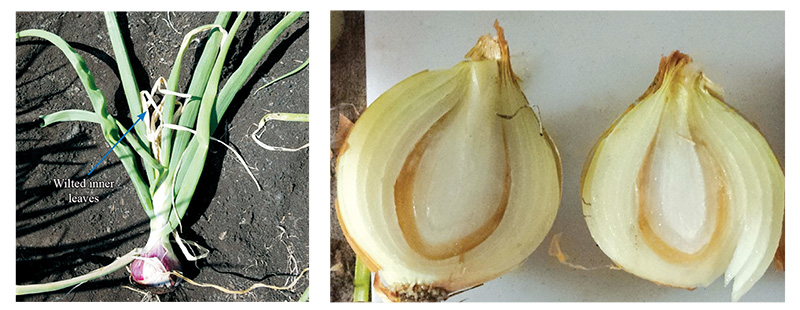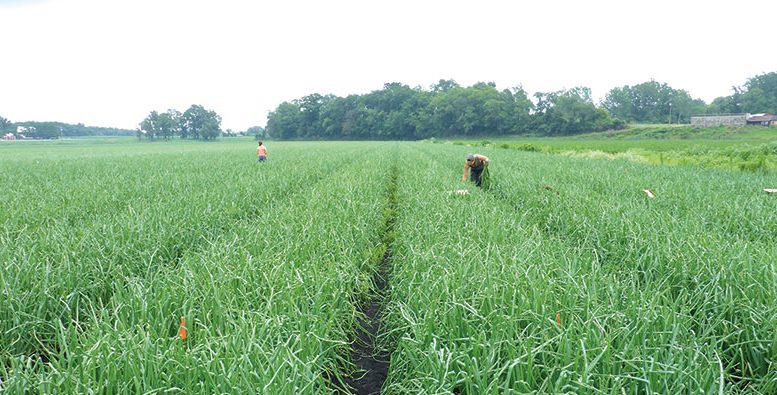Studies in Michigan and New York Highlight Potential for Reducing Nitrogen Rates on Muck Soils
By Zachary D. Hayden, Michigan State University; Ashley Leach and Brian Nault, Cornell University
In the Great Lakes region, dry bulb onions are primarily produced on muck soils. Also called organic soils or Histosols, these unique soils are formed by the accumulation of partially decomposed plant material in marshy areas over centuries. As a result, muck soils are characterized by high levels of organic matter relative to mineral soils, often containing between 20 and 80 percent organic matter. Despite their potential to be naturally low in a number of other essential plant nutrients, organic matter mineralization in muck soils can release substantial amounts of nitrogen (N) for plant uptake each year.
Onions have a high demand for N, and adequate full-season N fertility is essential for maximizing onion bulb yield and quality. However, too much N can have negative consequences. Fertilization in excess of crop requirements risks wasting money on unneeded inputs and leaves N vulnerable to environmental losses. In addition, excess N fertility can influence onion maturation and quality and may interact with important pests and diseases. In particular, onion thrips (Thrips tabaci) and bacterial leaf blights and bulb rots can cause substantial yield and quality losses in the field and in storage, and the severity of both have been reported to be influenced by N fertility.
We conducted independent studies in commercial muck onion production systems in Michigan and New York that examined the effects of N fertilizer rates on onion yield and quality and potential impacts on onion thrips and the incidence of bacterial disease.
Effects on Marketable Yields
Experiments were conducted on commercial farms near Hamilton, Michigan, and Elba, New York, in 2017 and 2018. In Michigan, treatments included four total N fertilizer rates (90, 140 190 and 240 lb N ac-1) applied as urea, each consisting of 90 lb N ac-1 applied pre-plant by the grower and the remainder of the N top-dressed in mid-June. In New York, treatments included five total N rates (0, 60, 75, 105 and 135 lb N ac-1) applied as urea, with all but the no N control consisting of 60 lb N ac-1 applied at planting and the remainder of the N top-dressed in June. Onion cultivars were Bradley both years in New York, and Aldrin in 2017 and Champ in 2018 in Michigan. Onions were planted in April, harvested in September, and graded and weighed by size category.
Across sites and years, there was no impact of N rates above 60 or 90 lb N ac-1 on marketable yield in New York and Michigan, respectively (Fig. 1). Furthermore, in 2018 in New York, yields in all N treatments were similar to the unfertilized control. In Michigan, increasing N rates also did not influence bulb size in either year (data not shown).
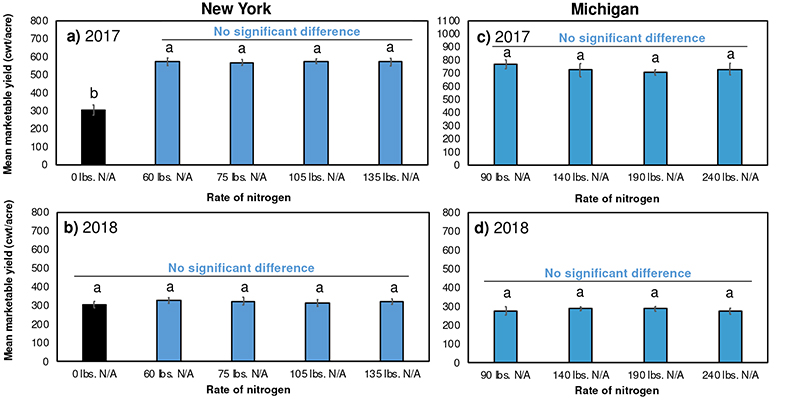
These results are consistent with a number of previous studies in New York, Michigan and Ontario, Canada, and highlight that for many muck fields, the full standard recommended total N fertilizer rate (125-140 lb N ac-1 in New York and Michigan) is not necessary to optimize onion yield and quality. More research is needed to identify the optimal rates of N fertilizer for onion production in muck soils.
Interactions with Pests, Disease, Storage Quality
Beyond fertilizer input costs and potential environmental losses, does oversupplying N result in other key risks for an onion crop?
In New York, Cornell researchers looked at the impact of N fertilizer rate on onion thrips populations during the season, and on the incidence of bacterial foliar symptoms and bulb rot. There was no evidence that N rates influenced season-long onion thrips infestations in the field, suggesting that N fertilizer decisions are unlikely to impact management of this pest.
On the other hand, in New York in 2017, the incidence of bacterial disease (both the percentage of infected leaves and the percentage of rotting bulbs after harvest) increased with increasing rates of N fertilizer (Fig. 2). However, levels of bulb rot did not differ significantly between 60 lb N ac-1 and 135 lb N ac-1. In Michigan, conditions did not favor bacterial rot, and no incidence was observed in either year. The take-home message is that higher N rates may predispose onions to bacterial rot, but many other factors including weather, field history, water management and storage conditions will be important in determining the likelihood of losses.
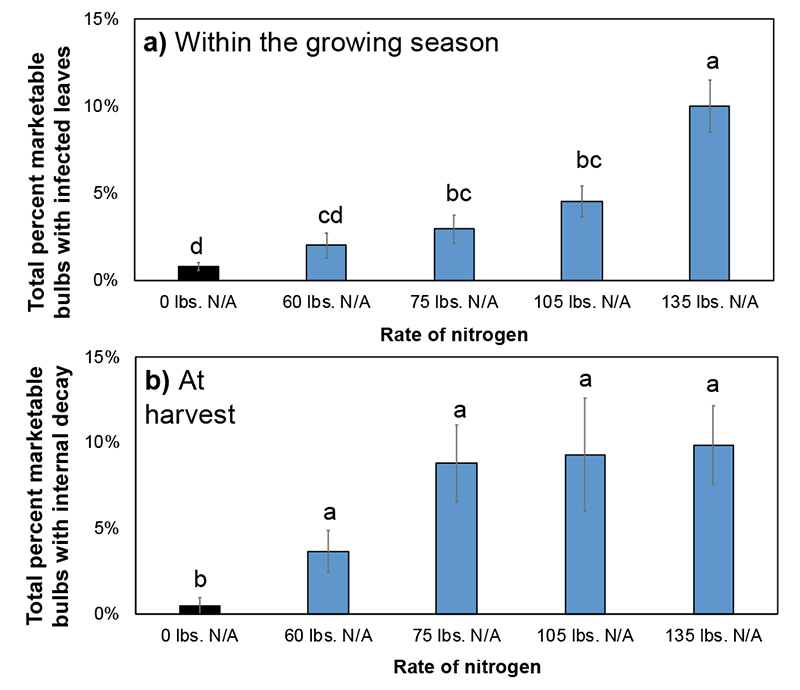
Excess N has the potential to delay onion maturity. In New York, onion maturity was delayed by an average of 10 days in 2017 (data not shown); however, no differences in maturity were observed in 2018. Michigan State University researchers did not observe differences in the timing of maturity across N rates in either year. In 2017 in Michigan, a larger percentage of bulbs exhibited sprouting in storage with increasing N rates (Table 1), although the bulbs had been in storage for an extended period (six months) at 50 degrees Fahrenheit before evaluation. Nevertheless, these results do indicate that excessive N fertility has the potential to negatively impact some aspects of storage quality.
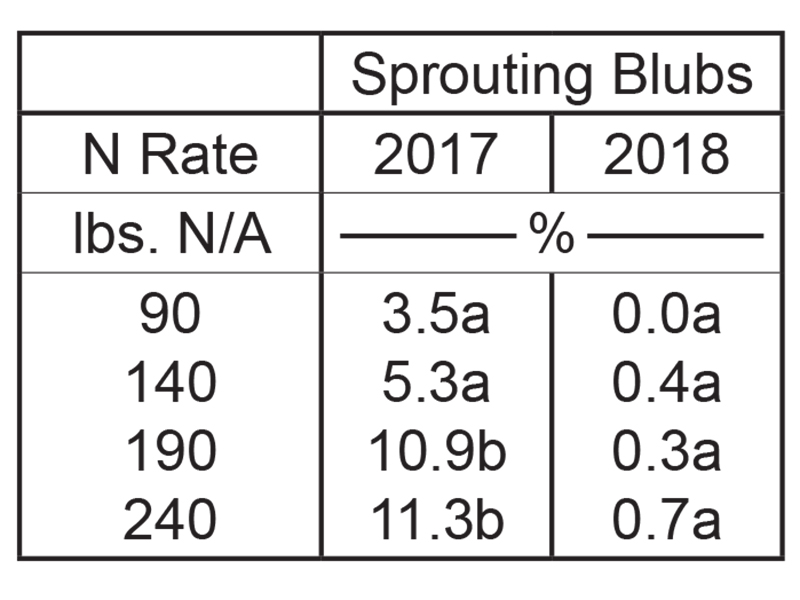
Nitrogen Management Implications
Cornell and Michigan State University N recommendations for dry bulb onions grown on muck soils are 125 and 140 lb N ac-1, respectively. These recommendations already consider the potential for greater N availability from organic matter mineralization on muck. However, our results highlight that for many fields, growers can maximize yields, reduce risks of exacerbating disease and storage quality issues, and save money by applying significantly less N fertilizer.
A recent survey suggested that one in three muck onion growers in New York have already reduced their N rates to less than 60 lb N ac-1. The challenge is that muck soils vary in their ability to supply N due to factors such as organic matter content and quality, depth and weather conditions that can promote N loss during the growing season. This makes broad recommendations to reduce N rates difficult, but knowledge of soil characteristics and a smart fertilization strategy can help dial in the right rate.
Onions grow slowly in the first six weeks after planting, so broadcast and incorporate only 50 to 60 lbs N ac-1 prior to planting. Alternatively, if N is applied using a starter fertilizer near the seed, this amount can be reduced to 40 lb N ac-1. Later in mid-June (3-4 leaf stage) before onion N demand increases rapidly, side- or top-dress the remaining N fertilizer (up to 90 to 100 lbs N ac-1). This also provides an opportunity to evaluate available soil N content and reduce side-dress N rates accordingly.
Previous studies in Michigan have shown that a pre-side-dress soil nitrate test (PSNT) can provide a good indication of how much N is available in the soil and how much side-dress N fertilizer can be reduced without impacting yield. Muck soils vary widely in their bulk density (the weight of soil in a given volume), so calculating specific N credits from PSNT values is more soil specific than for mineral soils and requires an estimate of bulk density. However, as a conservative ballpark estimate, current research suggests that muck onion fields with PSNT values greater than 60 ppm in the top 12 inches may be unlikely to exhibit an economic response to additional N fertilizer. While more research is needed to confirm this estimate across soils and years, muck onion fields exceeding this threshold prior to side-dress should be targeted for reduced N fertilizer rates.
